Most people don’t know that when it comes to disc brake rotor problems, often the rotor is not the culprit at all. It may surprise many that when you troubleshoot the problem, it reveals that the root cause is anything but the rotor. The good news is, when you closely examine the rotor, it can help you identify what the actual problem is. Check out these tips to help you spot the true defect, as well as the causes and possible solutions to each one.
Cracked Pot or Hat. If you see that the disc pot near a wheel bolt is cracked, one possible cause is that one or more of the bolts are poorly press-fitted. To solve this problem, you should simply make sure to press-fit the bolts according to your manufacturer’s recommendation.
Judder and noise. If you hear any abnormal noise, or through visible checks, find some overheating marks on the outside of the friction ring as well as some pad material deposits and cracks, it might be caused by some jammed bushings and guide. To solve this, you must replace those bushings or perhaps the complete caliper set, if necessary. Other possible causes include the possibility of the brake not releasing, or the pistons are jammed or rusted solid in caliper, or the pads are jammed in the caliper. If the guides stiff, it might also be a reason for the problem. In order to avoid and repair these, you must check calipers for free movement, the residual pressure in the system and inspect the pads and bushings. Also, you must be careful the next time you are driving not to overstrain the brakes.
Shimmy and Noise. If you notice heat bluing on both sides of the friction ring after every little use of the car, check for possible inadequate bedding-in, overstraining of brakes, residual pressure in the system, pistons jammed in the caliper, and stiff guides. Another possible clue, which you can inspect visually, is if the layer of rust on the friction ring is lifting. This might be caused by some water damage or an extended service life that has resulted in a badly rusted disc. To solve these problems, follow some of the same advice given above, and thoroughly inspect the hydraulic system. Avoid overstraining of the brakes and follow bedding-in and operating instructions. You must also check the caliper channel and the pads for free movement and lightly grease the caliper and pad contact surfaces.
So the next time you think you have a problem with your disc brake rotor, think again. It is closely related to so many other car accessories that may be the actual causes of the problem. Knowing the roles of these parts will also help you properly maintain your vehicle.
If you would like to purchase high quality parts and accessories online with great discounts, check out autopartsway.com.



